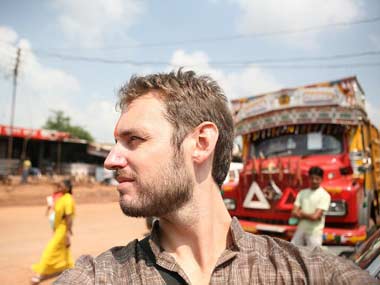By Uttara Choudhury These days we hear a lot about the clash of the two Indias — deprived India Vs shining India. But just as we begin to believe the hype about the shining new India, a book filled with freakish, ghoulish and plain tragic stories comes along with the force of a hurricane to remind us of the old India. American investigative journalist Scott Carney’s unsettling new book The Red Market makes a reality check especially pertinent as it exposes India’s booming underground trade in human organs. [caption id=“attachment_21565” align=“alignleft” width=“380” caption=“The author has lived in Chennai for five years, speaks Hindi and has crisscrossed India several times on his Royal Enfield Bullet. Image courtesy: scottcarney.com”]
 [/caption] Carney’s book also shines a spotlight on Egypt, Pakistan, China and the Philippines, but India sadly dominates the world’s “red market", in which bones, kidneys, wombs, and human hair are harvested from the poorest people and sent to buttress American and European bodies. The author has lived in Chennai for five years, speaks Hindi and has crisscrossed India several times on his Royal Enfield Bullet so he knows India pretty well, especially its granularity. On an assignment for the National Geographic and WIRED News, Carney helped break a story about kidney brokers who sell human organs to foreign medical tourists in South India. This propelled Carney to expand his investigation and write this book. Carney’s eye misses very little from the horrifying to the ironic; his book describes an Indian village nicknamed ‘Kidneyvakkam’ because most of its residents have sold their kidneys for cash. Wealthy patients expecting an automatic spot on the transplant list may not be thrilled to hear this, but Carney implies that the handful of years most kidney transplant recipients gain from the operation may not be worth the cost in third world exploitation. “Every kidney, cornea, or pint of blood has to come from somewhere — or, more precisely, someone. Forget the image of grass-skirt-wearing cannibals on tropical islands; no society has had as insatiable an appetite for human flesh as the developed world of the 21st century,” writes Carney. “In Egypt, India, Pakistan, and the Philippines, entire villages sell organs, rent wombs.” And the illusion that people selling their tissue “benefit from the transaction” is a devastating fantasy. “People who sell bodies and body parts rarely see their lives improved,” Carney writes passionately. [caption id=“attachment_21586” align=“alignleft” width=“150” caption=“The Red Market published by Harper Collins”]
[/caption] Carney’s book also shines a spotlight on Egypt, Pakistan, China and the Philippines, but India sadly dominates the world’s “red market", in which bones, kidneys, wombs, and human hair are harvested from the poorest people and sent to buttress American and European bodies. The author has lived in Chennai for five years, speaks Hindi and has crisscrossed India several times on his Royal Enfield Bullet so he knows India pretty well, especially its granularity. On an assignment for the National Geographic and WIRED News, Carney helped break a story about kidney brokers who sell human organs to foreign medical tourists in South India. This propelled Carney to expand his investigation and write this book. Carney’s eye misses very little from the horrifying to the ironic; his book describes an Indian village nicknamed ‘Kidneyvakkam’ because most of its residents have sold their kidneys for cash. Wealthy patients expecting an automatic spot on the transplant list may not be thrilled to hear this, but Carney implies that the handful of years most kidney transplant recipients gain from the operation may not be worth the cost in third world exploitation. “Every kidney, cornea, or pint of blood has to come from somewhere — or, more precisely, someone. Forget the image of grass-skirt-wearing cannibals on tropical islands; no society has had as insatiable an appetite for human flesh as the developed world of the 21st century,” writes Carney. “In Egypt, India, Pakistan, and the Philippines, entire villages sell organs, rent wombs.” And the illusion that people selling their tissue “benefit from the transaction” is a devastating fantasy. “People who sell bodies and body parts rarely see their lives improved,” Carney writes passionately. [caption id=“attachment_21586” align=“alignleft” width=“150” caption=“The Red Market published by Harper Collins”]
 [/caption] It is a sobering thought that most Indian “donors” get as little as Rs 36,000 for their organs — though some are promised more — not enough to make a significant difference in their lives or lift them out of poverty for more than a year. Carney emphasises that the bulk of the money forked over by the recipient is pocketed by greasy middlemen. Laura Miller, a senior writer for Salon, applauds Carney’s book for making Westerners aware of how much their survival may have cost others, but she pragmatically points out that most people would countenance a good deal of “dodgy behaviour” if it meant a few more years of life for themselves or a loved one. In 2009, Carney tracked down a boy who had been kidnapped from an Indian slum by an orphanage and sold by an adoption agency to unsuspecting American parents. Carney’s book captures the devastation of the Indian family and chronicles how they ran from pillar-to-post trying to find their son. The author then brings the reader up to speed with how the US couple that may have adopted the boy are resisting attempts to establish the child’s identity, even though the Indian father tells Carney he understands “it’s not realistic for us to ask for him back, but at least let us know him.” On the crowded streets of Kolkata Carney also uncovers a vast network of traders who rob graves to steal human bones to sell to American anatomy classrooms. If you are talking about villainy, the unscrupulous grave robbers pale in comparison to an Indian farmer Carney writes about who imprisoned several men in one of his sheds for three years, extracting their blood to sell to a nearby hospital. This book deals with a depressing theme, but comes at time when the Indian government must really decide how closely it will protect its poorest from becoming salable “spare parts” for privileged Western patients.
[/caption] It is a sobering thought that most Indian “donors” get as little as Rs 36,000 for their organs — though some are promised more — not enough to make a significant difference in their lives or lift them out of poverty for more than a year. Carney emphasises that the bulk of the money forked over by the recipient is pocketed by greasy middlemen. Laura Miller, a senior writer for Salon, applauds Carney’s book for making Westerners aware of how much their survival may have cost others, but she pragmatically points out that most people would countenance a good deal of “dodgy behaviour” if it meant a few more years of life for themselves or a loved one. In 2009, Carney tracked down a boy who had been kidnapped from an Indian slum by an orphanage and sold by an adoption agency to unsuspecting American parents. Carney’s book captures the devastation of the Indian family and chronicles how they ran from pillar-to-post trying to find their son. The author then brings the reader up to speed with how the US couple that may have adopted the boy are resisting attempts to establish the child’s identity, even though the Indian father tells Carney he understands “it’s not realistic for us to ask for him back, but at least let us know him.” On the crowded streets of Kolkata Carney also uncovers a vast network of traders who rob graves to steal human bones to sell to American anatomy classrooms. If you are talking about villainy, the unscrupulous grave robbers pale in comparison to an Indian farmer Carney writes about who imprisoned several men in one of his sheds for three years, extracting their blood to sell to a nearby hospital. This book deals with a depressing theme, but comes at time when the Indian government must really decide how closely it will protect its poorest from becoming salable “spare parts” for privileged Western patients.
'The Red Market' is a shocking tour of India’s body bazaar
FP Archives
• February 8, 2021, 17:23:43 IST
The book exposes India’s booming underground trade in human organs and demolishes the illusion that people selling their tissue benefit from the transaction.
Advertisement
)